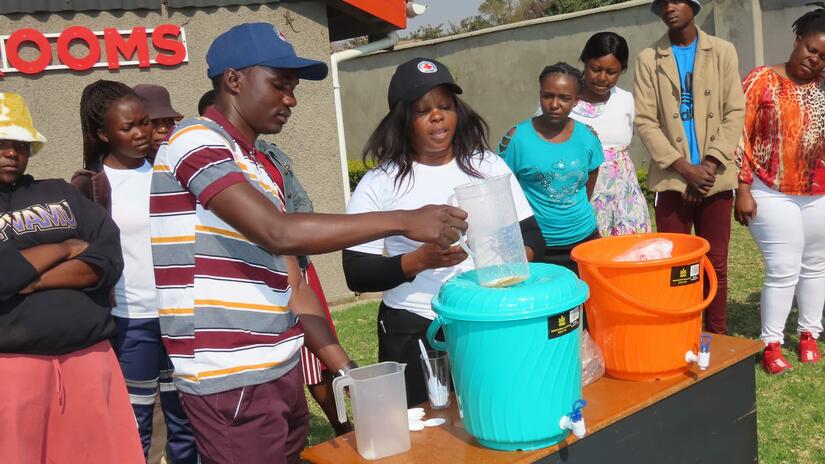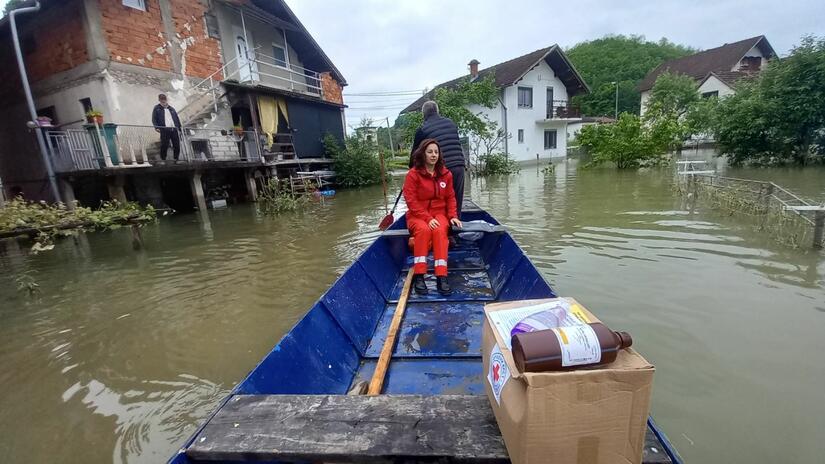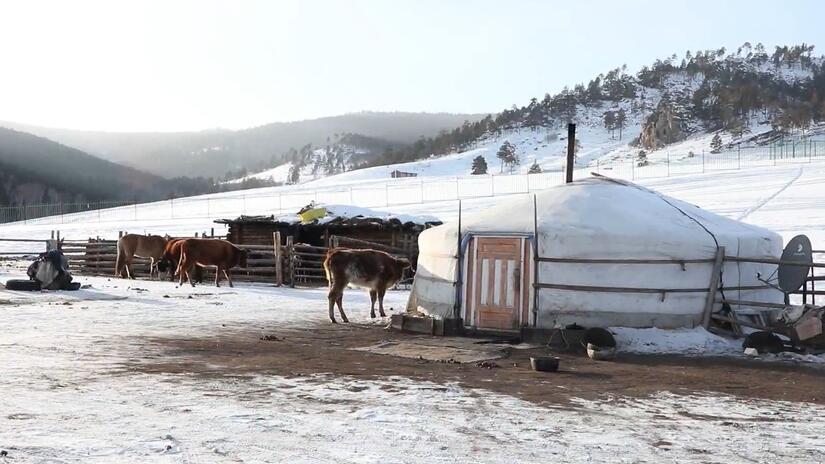Maybe it's because the disaster happened in a remote, rural area, far from media hubs. Maybe it’s “too small” to warrant a global reaction. Whatever the reason, some emergencies don't get as much attention as others. For the people living through these crises, however, they are just as real, heartbreaking and life-changing as the big catastrophes that go viral or that benefit from the ‘CNN effect’.
And when you’ve lost your home to a flood, fire or landslide – or you’ve had to leave town with nothing but the clothes on your back – you don’t have time for the world to catch on.
This is why the IFRC has a rapid-response funding mechanism called the Disaster Response Emergency Fund (IFRC-DREF) that gets funds quickly to all crises, large or small. Here are ten of the least-known disasters that IFRC-DREF responded to in 2023.
1. El Nino in Ecuador

An Ecuadoran Red Cross volunteer brings supplies to people impacted by landslides caused by heavy rains.
Photo: Ecuadoran Red Cross
In the later half of 2023, extreme rainfall generated by the El Niño phenomenon on the Ecuadorian coast caused rapid flooding. Fortunately, affected communities were more prepared than in the past thanks to actions they took ahead of the rains. When the El Nino’s impacts were first forecast, government agencies declared that preparing for and preventing damage from the expected heavy rains was a national priority. For its part, the IFRC-DREF allocated funds to ensure 1,000 at-risk families would have safe drinking water, proper waste management, food set aside and many other precautionary measures.
2. Cholera outbreak in Zimbabwe

Zimbabwe Red Cross responds to cholera outbreak with community based hygiene support and education.
Photo: Zimbabwe Red Cross
Like many other relatively localized or regional epidemics, the cholera outbreak in Zimbabwe in 2023 has received little international attention. It started in February 2023 and to date, suspected and confirmed cases have been reported in 41 districts in all the country’s 10 provinces. The IFRC has launched an emergency appeal to support the work of the Zimbabwe Red Cross, but even before that, IFRC-DREF dispersed CHF 500,000 to support 141,257 people with health care and water, sanitation and hygiene support in key impacted areas. The goal is to prevent and control the spread of Cholera, interrupt the chain of transmission, facilitate the improvement of case management and improve basic sanitation, hygiene practices and access to safe drinking water.
3. Floods in Bosnia-Herzegovina

Local Red Cross branches deliver humanitarian aid by boat after floods hit Bosnia and Herzegovina in May 2023.
Photo: Red Cross of Bosnia and Herzegovina
The northwestern area of Bosnia and Herzegovina experienced intense rainfall in mid-May 2023, causing widespread flooding and extensive damage to people’s houses and local infrastructure. The floods also destroyed crops and rendered much farmland and dairy production inoperable. It was a severe blow to one of the lowest-income areas in Europe, a region that relies on local agriculture for sustenance and income. IFRC-DREF allocated CHF 126,504 to the Bosnian Red Cross to support 1500 people through a variety of assistance measures, including cash transfers, distribution of essential equipment and hygiene supplie, and dissemination of health information, among other things.
4. Storms and floods on top of drought and conflict

As flooding in Yemen has become increasingly severe, IFRC-DREF has supported Yemen Red Crescent efforts to help people who lost homes and livelihoods.
Photo: IFRC
Sometimes disasters are hidden by the larger crisis enveloping a particular region. The scale of the humanitarian suffering in Yemen is so massive and widespread, there was little notice of the tropical cyclone that hit the country in October 2023. Tropical Cyclone Tej made landfall over the southern coast of Al Mahrah Governorate on the night of 23 October and continued to move northwestward. The cyclone caused widespread flooding, infrastructure destruction, displacement of communities, and the loss of many lives. IFRC-DREF quickly supported the response of Yemen Red Crescent with CHF 281,000 to support internally displaced people, host communities, returnees, marginalized groups, and migrants/refugees.
5. Fires in Chile

Chilean Red Cross teams respond to health needs of local residents after fast-spreading wildfires in 2023.
Photo: Chilean Red Cross Society
In Febuary 2023, strong winds and high temperatures caused dozens of forest fires across central and southern Chile, leading to casualties and widespread damage. They followed earlier, destructive forest fires in December 2022 that spread rapidly around the city of Viña del Mar. With IFRC-DREF funding, the Chilean Red Cross provided support to more than 5,000 people. Staff and volunteer teams provided medical support and distributed cash so that people could buy the things they needed to recover. More information.
6. Deadly Marburg outbreak in Gabon

Marburg outbreaks have also impacted other countries, including Equatorial Guinea (pictured here), where Red Cross volunteers go into the community to raise awareness and prevent its spread.
Photo: Sao Tome Red Cross
In early February 2023, the Government of Equatorial Guinea reported the death of nine people who presented symptoms of hemorrhagic fever and soon after the WHO confirmed the country was experiencing an epidemic of Marburg disease. The Gabon Red Cross contributed to the government’s preventive measures and by 15 May, the epidemic over. Roughly CHF 140,000 in emergency DREF funds are now being used to increase the Gabon Red Cross’s ability to respond to Marburg disease and other outbreaks in the future by ensuring the mobilized personnel can detect suspected cases quickly, anticipate spread and prepare for a coordinated response with health authorities.
7. Severe hail storms in Armenia

Severe hailstorms in northern Armenia in June 2023 damaged the homes and crops of hundreds of rural families who depend on agriculture to survive.
Photo: Armenian Red Cross
In June 2023, severe hailstorms struck various regions of Armenia, causing extensive damage and disruption. In the southern region, rural communities near the border experienced heavy precipitation that overwhelmed sewage systems, flooded streets and houses, and rendered roads and bridges impassable. The hail and subsequent flooding resulted in significant damage to houses, livestock, gardens, and food stocks. IFRC-DREF quickly allocated CHF 386,194 to support Armenian Red Cross's efforts to help 2,390 people who lost crops, livelihoods or who suffered extreme damage to their homes.
8. Population Movement in Benin

People displaced by violence in Burkina Faso gather at a distribution point set up but the Benin Red Cross.
Photo: Benin Red Cross
Around the world, there are hundreds of places where people are fleeing violence that rarely gets reported in international media. Here’s one case in point: over the past three years, non-state armed groups in the Sahel region has increased in the border area of Burkina Faso with Benin and Togo, forcing thousands to leave their homes. The IFRC-DREF allocated CHF 259,928 to support Benin Red Cross in assisting displaced people and host communities in Benin. The funds were used to provide immediate food and material aid to the most vulnerable households, covering immediate needs (shelter, access to drinking water, basic household supplies) for at least 3,000 people.
9. Cold spells and snowstorms in Mongolia

Unusually low temperature cold snaps have taken the lives of people and livestock in some parts of Mongolia.
Photo: IFRC
A devastating snowstorm swept across eastern parts of Mongolia and certain provinces in Gobi areas, starting on 19 May 2023. The storm brought high winds and 124 people (mostly from herder community) were reported missing after following their livestock, which wandered off because of the storm. A total of 122 people were found, but tragically 2 people died. There were also severe damage to infrastructure, including the collapse of 22 electricity sub-stations, which caused power outage in several counties. Nearly 150 households suffered loss or severe damage to their “gers” or yurts (traditional circular, domed structures), as well as widespread death of livestock. IFRC-DREF allocated CHF 337,609 to support the Mongolian Red Cross's efforts to provide shelter, cash assistance and psychosocial support to 3,400 people.
10. Drought in Uruguay

Uruguay has been experiencing widespread drought due to a lack of rainfall since September 2022. With funding from the DREF, Uruguayan Red Cross teams are supporting those most affected with vouchers for the purchase of livestock and agricultural supplies.
Photo: Uruguayan Red Cross
Uruguay is currently experiencing widespread drought due to a lack of rainfall since September 2022 and increasingly high temperatures in the summer seasons—prompting the Uruguayan government to declare a state of emergency. The government officially requested the support of the Uruguayan Red Cross to conduct a needs assessment of the drought, so it could understand how it was impacting people and agricultural industries. With funding IFRC-DREF, Uruguayan Red Cross teams headed out into the most-affected areas to speak to more than 1,300 families about the drought’s impact on their health, livelihoods and access to water. Their findings are helping the government make more informed decisions on how to address the drought, taking into account the real needs of those affected. More information.

